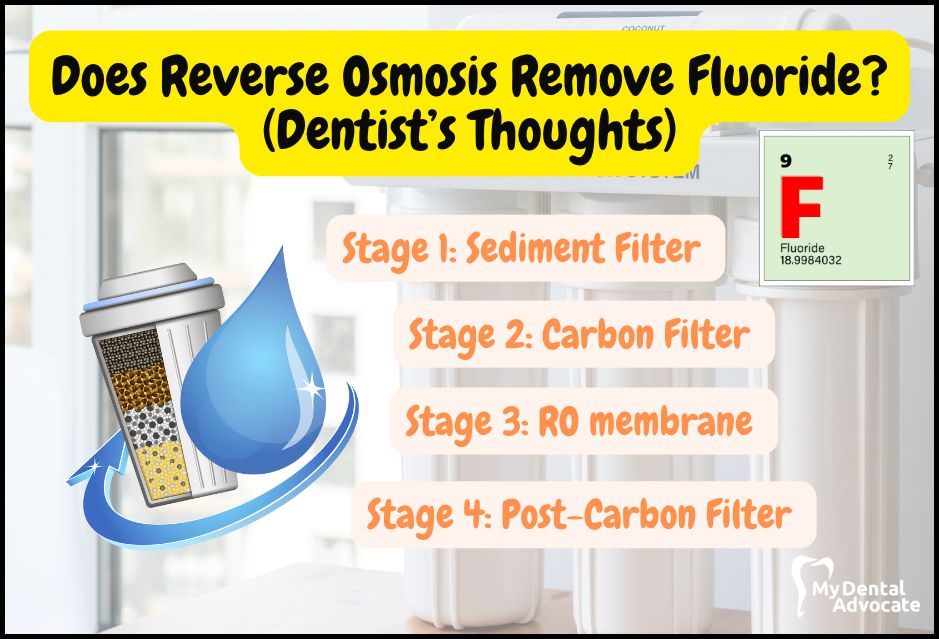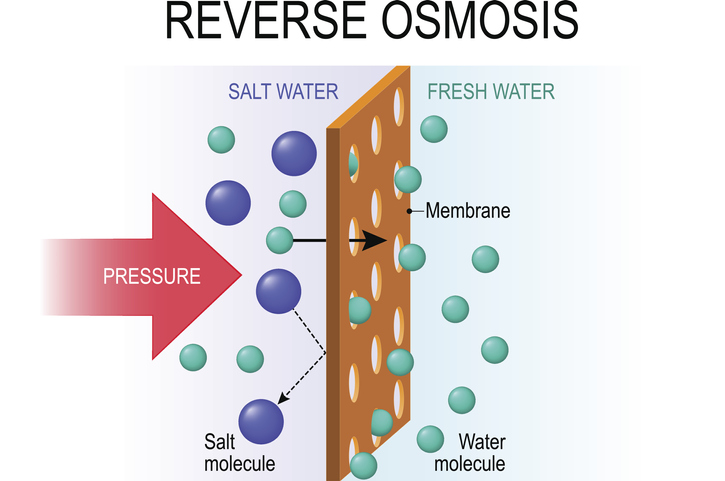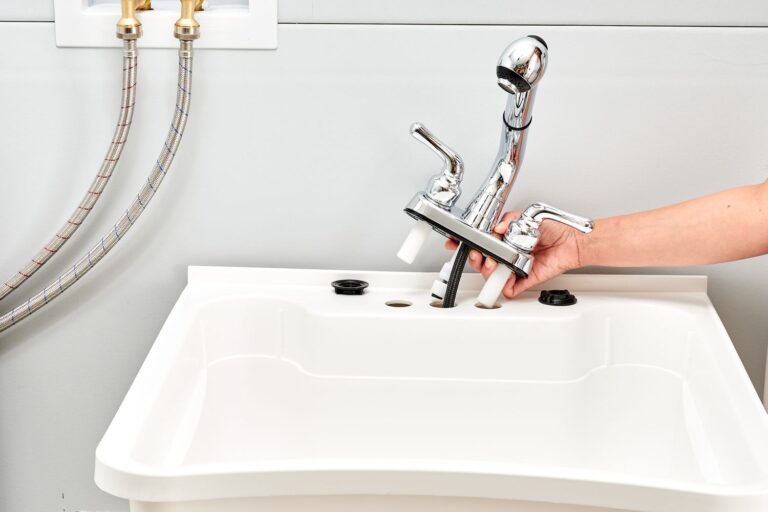Does Reverse Osmosis Remove Fluoride
Reverse osmosis is a water purification technology that is commonly used to filter out contaminants from water. It works by pushing water through a semi-permeable membrane, which can remove various particles and pollutants from the water. One of the most common questions people have when it comes to reverse osmosis is whether or not it is capable of removing fluoride from drinking water. The answer is yes, reverse osmosis is capable of removing fluoride from water, although it is only effective in certain water conditions and with the right equipment.
What is Reverse Osmosis?
Reverse osmosis (RO) is a filtration process that is used to remove impurities or contaminants from water by forcing it through a semi-permeable membrane. It is one of the most commonly used methods for purifying water and is effective at removing a wide range of substances, including bacteria, viruses, and dissolved salts. But does it remove fluoride?
The answer is yes, reverse osmosis is a highly effective way to remove fluoride from drinking water. During the RO process, the water passes through a semi-permeable membrane that has tiny pores that remove fluoride molecules from water. While some RO systems are designed to specifically target fluoride, others are also able to remove other contaminants such as lead, nitrates, and arsenic.
When selecting a reverse osmosis system, it is important to choose one that has been certified to remove fluoride. Look for systems that have NSF/ANSI Standard 58 certification. This certification means that the system has been tested and verified to remove fluoride from drinking water.
In conclusion, reverse osmosis is an effective method for removing fluoride from drinking water. When selecting a reverse osmosis system, make sure to choose one that is NSF/ANSI Standard 58 certified to ensure that it will remove fluoride from water.
How Does Reverse Osmosis Work?
Reverse osmosis (RO) is a type of water filtration technology that works by forcing water through a semi-permeable membrane to remove impurities like fluoride. This process is known as reverse osmosis, and it involves removing unwanted particles and compounds from the water while allowing desirable ones to pass through. During this process, the water is pressurized against a semipermeable membrane, which acts as a barrier, preventing the unwanted particles from passing through. The pressure pushes the water molecules through the membrane, while the larger particles and compounds are prevented from entering. This process removes fluoride from the water, as well as other dissolved solids, such as heavy metals, bacteria, pesticides, and other contaminants. Reverse osmosis is an effective way to remove fluoride from drinking water, and it is becoming increasingly popular in both residential and commercial applications. Not only is it highly effective in removing fluoride, but it is also relatively affordable and easy to maintain.
What is Fluoride?
Fluoride is a mineral found in certain food and water sources. It’s often added to drinking water to help protect teeth from decay. While fluoride helps protect teeth, it can be harmful if consumed in high doses. Too much fluoride can cause discoloration of the teeth, bone damage, and other health issues. That’s why it’s important to know how to remove fluoride from your drinking water, especially if you’re consuming water from a source that has been known to contain high levels of fluoride. One of the most popular methods for removing fluoride from drinking water is reverse osmosis. In this blog post, we’ll discuss how reverse osmosis works and whether or not it’s effective for removing fluoride.
Reverse osmosis is a process that uses a semi-permeable membrane to filter out particles, including fluoride, from water. This process works by pushing water through the membrane, which allows only water molecules to pass through. Any fluoride particles that are larger than the molecules are left behind. Reverse osmosis is an effective method for removing fluoride from water, as it can remove up to 95% of fluoride particles. It’s also a popular method for removing other contaminants from drinking water, such as lead, arsenic, and chlorine.
In conclusion, reverse osmosis is an effective way to remove fluoride from drinking water. However, it’s important to note that reverse osmosis is not a complete solution for removing all contaminants from drinking water. It’s important to regularly test your water for any contaminants and to use other methods for removing them if necessary.
Does Reverse Osmosis Remove Fluoride?
Reverse osmosis (RO) is a filtration process used to purify water by pushing it through a semi-permeable membrane. While it is a highly effective way to remove contaminants, the question of whether it can remove fluoride remains. The answer is yes, but with certain caveats.
RO systems are capable of removing fluoride, but not all RO systems are designed to do so. The effectiveness of the system depends on the type of membrane used. RO membranes made of polyamide thin-film composite materials are the most effective at removing fluoride, with removal rates of up to 95%. Other types of membranes, such as cellulose acetate and polysulfone, are less effective and may only remove fluoride up to 80%.
In addition to the type of membrane, the pH of the water being treated also affects the effectiveness of fluoride removal. Water with a lower pH, which is more acidic, will have higher fluoride removal rates. The higher the pH, the lower the fluoride removal rate, with near zero removal at a pH greater than 8.0.
In conclusion, reverse osmosis can effectively remove fluoride from water, however, the system must be designed with the right type of membrane and the water must have a lower pH for optimal results. It is important to do your research and find an RO system that is specifically designed to remove fluoride in order to get the best results.

Advantages and Disadvantages of Reverse Osmosis
Reverse osmosis (RO) is a popular water filtration method that has been gaining in popularity due to the convenience and cost-effectiveness it provides. In addition to its ability to remove sediment, bacteria, and other unwanted substances from drinking water, RO can also be used to remove fluoride. But while this process has its benefits, there are some drawbacks to consider as well.
When it comes to the advantages of using RO to remove fluoride, it is highly efficient and cost-effective, as well as providing a reliable source of clean drinking water. RO systems take advantage of a process known as reverse osmosis, which forces water through a membrane that removes contaminants, including fluoride. This means that it can be used to filter out a wide range of contaminants and provide a consistent supply of clean drinking water.
However, there are some drawbacks to using reverse osmosis to remove fluoride. The process is energy intensive and requires a significant amount of water to be wasted in order to filter out the contaminants. Additionally, the process can remove beneficial minerals from the water, leaving the water with a flat taste. Finally, the RO systems can be expensive to install and maintain, making them cost-prohibitive for some households.
In conclusion, while reverse osmosis can be an effective way to remove fluoride from drinking water, there are some drawbacks to consider. It is energy intensive and requires a significant amount of water to be wasted in order to filter out the contaminants. Additionally, the process can remove beneficial minerals from the water, leaving the water with a flat taste. Finally, the RO systems can be expensive to install and maintain, making them cost-prohibitive for some households.
Other Methods of Fluoride Removal
Removing fluoride from drinking water can be done in a variety of ways. Reverse osmosis is just one option, but it is not the only one. Other methods of fluoride removal include distillation, activated alumina filtration, ion exchange, and nanofiltration. Each of these methods comes with its own pros and cons, and some may be better suited for certain situations than others.
Distillation is a simple yet effective method of removing fluoride from drinking water. In this process, water is heated until it is vaporized and then cooled until it condenses into liquid form again. The vaporized water is collected and the fluoride is left behind in the heating chamber. The downside to this method is that it requires a great deal of energy and is not as effective at removing other contaminants.
Activated alumina filtration is another common way to remove fluoride from water. This process uses a porous material made from aluminum oxide to absorb and trap fluoride. The downside is that it must be changed out regularly to prevent it from becoming saturated.
Ion exchange is a chemical process used to remove fluoride from water. In this method, the fluoride ions are exchanged for other ions in the water. The downside to this method is that it requires a great deal of maintenance and can be expensive.
Nanofiltration is a relatively new technique that uses tiny particles to remove fluoride from water. This method has the advantage of being more efficient than other methods, but it is also more expensive.
When it comes to removing fluoride from drinking water, reverse osmosis is just one option. Other methods such as distillation, activated alumina filtration, ion exchange, and nanofiltration may be better suited for certain situations. Each has its own pros and cons, so it is important to do your research and determine which method will work best for your needs.
Considerations When Choosing a Water Filtration System
When it comes to selecting a water filtration system, it’s important to understand the different types of filtration available and the pros and cons of each. Reverse osmosis (RO) systems are among the most popular, as they provide an effective way to remove fluoride and other impurities from drinking water. But there are other considerations to make when deciding which type of filtration system is best for your home or business.
For example, RO systems require more maintenance than other types of filtration, such as carbon filters. They also require additional pre- and post-treatment steps, such as sediment filters and pH adjustment, in order to ensure that the water is safe to drink. Additionally, RO systems can be expensive to install and operate, depending on the size and complexity of the system.
Other filtration systems, such as activated carbon or ultrafiltration, are more affordable and require less maintenance. While they may not be as effective as RO systems at removing fluoride, they can still help reduce the amount of fluoride and other contaminants in drinking water.
When choosing a water filtration system, it’s important to weigh the pros and cons of each type and determine which one is best suited to your needs. Consider the cost, installation requirements, and maintenance required, as well as the amount of fluoride and other impurities you want to remove from your water. With the right system, you can be sure your drinking water is safe and free from contaminants.
Conclusion
Reverse osmosis is a highly effective method for removing fluoride from drinking water. It can be used as a standalone system or in combination with other filtration methods. By removing up to 99% of fluoride from water, reverse osmosis systems are an excellent solution for those looking to reduce their fluoride intake. It’s important to note, however, that reverse osmosis systems are not a substitute for professional advice or medical treatment. If you’re concerned about your fluoride exposure, it’s best to speak with a doctor or a water specialist to find the best solution for your needs.
FAQs About the Does Reverse Osmosis Remove Fluoride
1. What is reverse osmosis and how does it work?
Reverse osmosis is a type of water filtration process that forces water through a semi-permeable membrane to remove contaminants, including fluoride. The process relies on pressure to push water molecules through the membrane, leaving behind larger molecules, such as fluoride, on one side of the membrane.
2. How effective is reverse osmosis at removing fluoride?
Reverse osmosis is a highly effective way of removing fluoride from drinking water. Reverse osmosis systems can reduce fluoride levels down to 0.1 parts per million (ppm) or lower, depending on the type and quality of the system.
3. Are there any drawbacks to using reverse osmosis to remove fluoride?
Yes, there are a few drawbacks to using reverse osmosis to remove fluoride from drinking water. The process requires a significant amount of energy and can be costly to install and maintain. Additionally, reverse osmosis removes beneficial minerals from the water, which may affect its taste and odor.
Conclusion
In conclusion, reverse osmosis does remove fluoride from water, but only if the proper filtration system is used. Reverse osmosis systems are designed to filter out impurities from water, including fluoride, but it is important to make sure the system is designed specifically for this purpose. Although reverse osmosis can remove fluoride, it is not always effective, and it may be necessary to supplement it with other forms of filtration to achieve the desired results.






